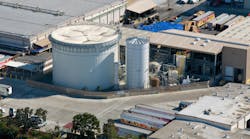The Kroger Co., by most measures the nation’s biggest grocery retailer (measures that don’t consider Wal-Mart a pure grocery retailer, that is), has come up with one of the quirkiest twists on clean energy I’ve yet seen. Kroger is using a clean energy production system powered by garbage to provide power to one of its distribution centers.
You heard right: Kroger’s Ralphs/Food 4 Less DC, based in Compton, Calif., operates by converting organic food waste (what you or I would call garbage) into renewable energy. This is no small operation by any means; the anaerobic conversion system is capable of processing as much as 55,000 tons of waste, sufficient to power the 650,000 sq. ft. DC. Basically, the system converts the carbon in the discarded and/or spoiled food to create a renewable source of methane.
The video below provides more of the details, but the gist of it is, all that rotten food gets transformed into renewable biogas, which is then converted into power in an oxygen-free environment that generates no odors, according to FEED Resource Recovery, the clean-tech company that designed the Kroger Recovery System. As long as you don’t dwell too long on the idea of effluent (essentially, sewage) keeping the lights on in the DC, it’s a pretty cool idea.
“We are committed to finding solutions for food waste and clean energy, and we believe this is a meaningful step forward,” says Rodney McMullen, Kroger’s president and COO. “Investing in this project is a good business decision for Kroger and, most importantly, an extraordinary opportunity to benefit the environment.”
The system as it’s currently configured offsets more than 20% of the energy inside the DC. There’s also a measurable logistics savings, in the reduction or elimination of trucks needed to haul all that trash to a composter. Kroger estimates the system will reduce the number of truck miles by a half-million miles per year.
So the next time somebody asks you where the next great idea in clean energy is coming from, just point to the nearest dumpster, and nod knowingly.



